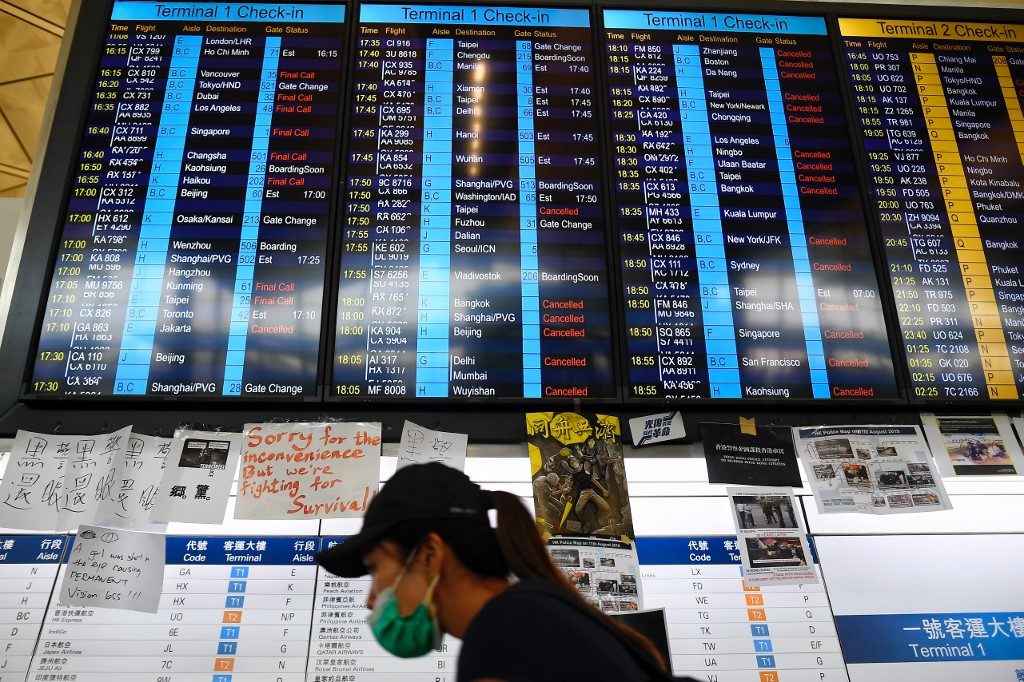SUMMARY
This is AI generated summarization, which may have errors. For context, always refer to the full article.

MANILA, Philippines – Thousands of pro-democracy protesters flocked to the Hong Kong International Airport (HKIA) on Monday, August 12, leading to cancellations of flights in and out of the region’s busiest hubs.
It is the latest in the crisis marred by protests and violence spanning at least 10 weeks already.
More than 5,000 people flooded HKIA where they denounced police violations and attacked China. This, according to authorities, “seriously disrupted” airport operations.
How vital is the HKIA? For starters, at least 1,100 flights arrive and depart daily. Here are other things you need to know:
1. HKIA is only 21 years old
The Hong Kong International Airport opened on July 6, 1998 and is located 30 kilometers northwest of Hong Kong Island. When it first opened its doors to the public, the airport was regarded as having the world’s largest passenger terminal buildings.
Before HKIA, Hong Kong was serviced by then 73-year-old Kai Tak Airport. The creation of the new airport was in line with the growth of Hong Kong as the region’s business hub. Besides, the increasing number of passengers had already gone beyond the design capacity of Kai Tak Airport.
The transition to the new airport, however, was not without any problems. When it was first opened in 1998, many said that facilities were not yet ready, including drainage systems and its baggage system.
HKIA’s first foreign visitors included then-United States president Bill Clinton whose presidential plane landed just hours after the airport was inaugurated.
2. HKIA sits on reclaimed land
The HKIA was built on reclaimed land on the Chek Lap Kok island which provided bigger space than the Kowloon City District where the old airport used to be. The construction reclaimed 9.38 square kilometers of the seabed.
According to reports, the 1,255-hectare site area contributed nearly 1% to the total surface area of Hong Kong.
The island was seen as a possible location as early as 1974, based on a planning study conducted by the Civil Aviation and Public Works department. The plan, however, was initially shelved due to financial constraints.
3. HKIA is one of the world’s busiest airports
An entry into the region’s financial hub, the Hong Kong International Airport is understandably very busy. It is estimated that over 1,100 flights arrive and depart from HKIA daily.
Fortunately, the airport can handle 68 flights per hour at peak hours.
Its website says that in 2018, the airport was connected to over 220 destinations globally through the service of at least 120 airlines.
HKIA has two terminals – Terminal 1 opened in July 1998, while Terminal 2 opened in June 2007.
In 2018, 74.7 million passengers and 5.1 million tons of cargo passed by HKIA, all meticulously handled by at least 73,000 staff. It has a total of 90 boarding gates and 78 jet bridge gates.
The airport also recorded 427,725 air traffic movements in the same period on its two runways.
4. HKIA is multi-awarded
The airport has consistently received awards for its top-notch service, including at least 70 “Best Airport Awards,” according to its website.
From 2016 to 2019, HKIA was named the “Best Global Airport” by Asia Cargo News. It also received the “Freighter Hub of the Year” award in 2019.
In 2018, it was named “Airport of the Year” by International Airport Review and “Best Airport in Asia” by Monocle. – Rappler.com
Add a comment
How does this make you feel?
There are no comments yet. Add your comment to start the conversation.